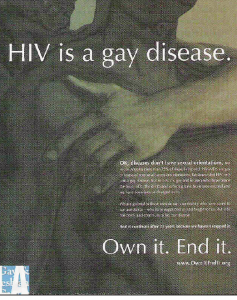How to Get Seniors on Our Side The bad news is that seven more states passed ballot measures in the recent election banning same-sex marriage—and in some cases civil unions—in their state constitutions. The good news is that one state, Arizona, became the first to vote down such a measure when its citizens rejected Proposition 107 last November. But why Arizona, that state of cowboys and allergy sufferers and above all retired persons, who don’t seem like natural fans of same-sex marriage? Actually, it turns out senior citizens were the decisive factor in Prop 107’s defeat—but not exactly because of their knee-jerk support for gay rights. It seems many elderly single persons in Arizona have paired off and as it were shacked up; but to avoid losing Medicare and Social Security benefits, they’ve been avoiding marriage. The trouble with Prop 107 was that it banned not only same-sex marriage but civil unions and domestic partnerships, as well. “We didn’t want to be living in sin,” said a 79-year-old woman, fearing that the ban would outlaw her eight-year, live-in relationship with a 75-year-old man. The biggest fear was that the ban would prevent unmarried seniors from making medical decisions for each other if one became ill. Okay, so opponents of same-sex marriage are always citing the “slippery slope”—what next, people marrying their dogs?—to counter the argument for marriage equality. But a different kind of slippery slope seems to have emerged: once you start banning certain types of relationships, there’s no telling where it will end.
Sloganeering It was bound to be controversial when L.A.’s Gay & Lesbian Center launched a $50,000 print ad campaign featuring the slogan, “HIV is a gay disease,” though perhaps they didn’t anticipate the  ferocity of the outcry. Part of the slogan’s shock value derived from the fact that it directly contradicted the slogan of the 1980’s, “AIDS is not a gay disease”—a message that was advanced to combat the popular belief that only gay people got HIV. Could it be that this message worked too well? The truth is, back in the 80’s AIDS was largely a gay disease, and in its ad the L.A. Center notes that even today about 75 percent of the men living with HIV in L.A. are gay or bi. So, empirically speaking, HIV both is and is not a gay disease—these are statements not of fact but of propaganda. And not only “our” propaganda. The L.A. Center’s ads became instant, juicy fodder for right-wing religious groups, which seized on the ad campaign and produced articles with gleeful titles like “California Homosexual Organization Admits HIV/AIDS Is a Gay Disease” (www.LifeSite.com). Getting gays to “admit” this seems to be very important to these groups for whatever reason, which may be argument enough not to admit it. More importantly, the slogan did succeed in opening up some old wounds within the GLBT community.
ferocity of the outcry. Part of the slogan’s shock value derived from the fact that it directly contradicted the slogan of the 1980’s, “AIDS is not a gay disease”—a message that was advanced to combat the popular belief that only gay people got HIV. Could it be that this message worked too well? The truth is, back in the 80’s AIDS was largely a gay disease, and in its ad the L.A. Center notes that even today about 75 percent of the men living with HIV in L.A. are gay or bi. So, empirically speaking, HIV both is and is not a gay disease—these are statements not of fact but of propaganda. And not only “our” propaganda. The L.A. Center’s ads became instant, juicy fodder for right-wing religious groups, which seized on the ad campaign and produced articles with gleeful titles like “California Homosexual Organization Admits HIV/AIDS Is a Gay Disease” (www.LifeSite.com). Getting gays to “admit” this seems to be very important to these groups for whatever reason, which may be argument enough not to admit it. More importantly, the slogan did succeed in opening up some old wounds within the GLBT community.
Annals of Unintended Consequences Another twist on the theme of anti-gay-marriage propositions occurred in Wisconsin, which passed the measure by a disturbingly healthy margin. There it was the state’s Republican Party that orchestrated the initiative in the hope that its presence on the ballot would draw conservative voters to the polls, a strategy that has worked well in other states. And so it did this time. But as it happens, Wisconsin has a large population of socially conservative Democrats, who flocked to the polls to support the proposition—and voted for Democratic candidates while they were at it. At the same time, the initiative attracted hordes of liberal university students, who voted against it and also voted for Democrats. As a result, Democratic candidates took many more seats than expected at all levels of government. The final upshot is that Wisconsin now has more Democrats and a superfluous constitutional amendment—they already had a statute on the books banning same-sex marriage; professors in Madison have announced that they’re looking for jobs out-of-state; and Wisconsin looks to the world to be slouching toward Oklahoma.
One Hip Secretary Even as the “Foleygate” scandal was playing itself out last October—right before the election, no less, and Republicans were lying low on the whole gay thing while stumping from town to town—a remarkable thing happened in the nation’s capital that had everyone rubbing their eyes. For there she was, Secretary of State Condoleezza Rice, swearing in an openly gay man, Mark Dybul, as the new global AIDS coordinator, an ambassador-level position, and then commenting appropriately about his partner, Jason Claire, and their future happiness together. And if that wasn’t enough, she then acknowledged the presence of Claire’s mother at the ceremony, referring to her as Dybul’s “mother-in-law.” Now that’s pretty hip. Even the First Lady—yes, Laura Bush was there too—smiled. Indeed an AP photo caught the happy gathering—Condi, Laura, Dybul, and Claire—as they posed for their close-up. Some people were not so happy, of course, and expressed their dismay in no uncertain terms. Peter Sprigg of the Family Research Council labeled Condi’s crack “profoundly offensive,” and larded it on by attacking the selection of Dybul for the post: “[P]utting a homosexual in charge of AIDS policy is a bit like putting the fox in charge of the henhouse,” he declared. Huh? Do these guys even try to make sense?
The Missing Seven Percent Kinsey just won’t go away. He’s famous for having said that ten percent of the male population is predominantly homosexual, but just about everyone today has conceded that the true figure is probably much lower, perhaps closer to three or four percent. But now a large New York study has found that nearly ten percent of self-proclaimed “straight” men have sex exclusively with other men. The study (conducted by Preeti Pathela for the NYC Dept. of Health and Mental Hygiene, reported on WebMD.com) involved interviews with a large sample of men (4,200), who were asked about their sexual behavior over the past year. Of the nearly ten percent who said they’d had sex only with other men, fully seventy percent were heterosexually married. In fact, this looks very much like the segment of men identified by Kinsey, who wasn’t concerned with labels but only behavior. Here, then, is the missing seven percent (or so), men who behave homosexually but don’t label themselves as “gay.” Now Kinsey did his research at a time when no one used that term and no one was “out” in our sense. A passionate advocate of sexual openness, Kinsey would undoubtedly be gratified to know that a decent slice of the population, several percent, is now able to live openly as gay. What might puzzle him is why an even larger number of same-sex-oriented people still choose to live in the closet.
It Takes a “Muscle Mary” Police in Dublin, Ireland, have launched a program to arrest gay-bashers in city parks, and they’re doing it by going undercover in gay cruising areas in the guise of “Muscle Marys” (as they’re apparently called in Ireland). Dubbed the “Pink Patrol,” the muscly men wear skin-tight jeans and T-shirts and use “the walk” to signal their intentions, and then wait to be attacked by thugs. So far the Patrol has made fourteen arrests. Whether the program could work in the U.S. is an intriguing question: it certainly gives new meaning to the concept of “entrapment.” One can imagine a defendant’s line in court: “But look how they were dressed, judge, they were just asking to get beat up!”





